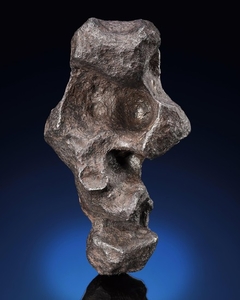MUNDRABILLA METEORITE NODULE — ONE MILLION YEARS ON EARTH, Iron medium octahedrite – IAB-UNGR Nullarbor Plain, Australia
Evocative of prehistoric or abstract art, numerous sockets and grooves animate this totem-like meteorite. It required 1,000,000 years of this object being exposed to and carved by the elements to result in the shape now seen. All ridges are smooth and the surface texture appears finely stippled in a light pewter patina with chocolate accents.
83 x 38 x 39 mm. (3¼ x 1½ x 1½ in.) and 345 g. (¾ lbs)
Unusual fetish-shaped meteorite. While engaged on a geological survey of Australia’s Great Nullarbor Plain, two geologists discovered the first Mundrabilla meteorites in 1911. It was later determined these meteorites were part of massive meteorite shower that occurred about a million years ago. Rich in sulfide, silicate and graphite inclusions, Mundrabilla is a most unusual meteorite with only one compositionally similar relative. As a result of its long tenure in Australia’s Nullarbor Plain (i.e., “null arbor”…no trees), a great number of the sulfide inclusions became oxidized, resulting in seemingly freeform nodules like this superior specimen.
Christie's would like to thank Dr. Alan E. Rubin at the Institute of Geophysics and Planetary Physics, University of California, Los Angeles for his assistance in preparing this catalog note.
View it on
Sale price
Estimate
Time, Location
Auction House
Evocative of prehistoric or abstract art, numerous sockets and grooves animate this totem-like meteorite. It required 1,000,000 years of this object being exposed to and carved by the elements to result in the shape now seen. All ridges are smooth and the surface texture appears finely stippled in a light pewter patina with chocolate accents.
83 x 38 x 39 mm. (3¼ x 1½ x 1½ in.) and 345 g. (¾ lbs)
Unusual fetish-shaped meteorite. While engaged on a geological survey of Australia’s Great Nullarbor Plain, two geologists discovered the first Mundrabilla meteorites in 1911. It was later determined these meteorites were part of massive meteorite shower that occurred about a million years ago. Rich in sulfide, silicate and graphite inclusions, Mundrabilla is a most unusual meteorite with only one compositionally similar relative. As a result of its long tenure in Australia’s Nullarbor Plain (i.e., “null arbor”…no trees), a great number of the sulfide inclusions became oxidized, resulting in seemingly freeform nodules like this superior specimen.
Christie's would like to thank Dr. Alan E. Rubin at the Institute of Geophysics and Planetary Physics, University of California, Los Angeles for his assistance in preparing this catalog note.



